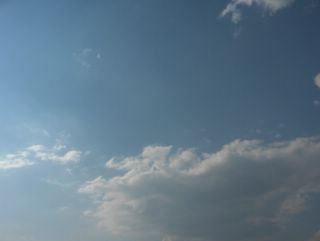
Tämä kuva on otettu samana iltapäivänä Espoon Tapiolassa kuin edellinen kuva, mutta nyt kohti luoteistaivasta. Kuvassa nähdään sama kumpupilvitilanne, missä myös edellisessäkin kuvassa ko. pilvilajin nähdään muuntuneen hieman kumpukerrospilvien suuntaan. Tämä on tyypillistä korkeapaineen alueella, jossa ilman vertikaalinen liike ylhäältä alas päin ehkäisee termiikin voimaa ylöspäin. Tämän vuoksi etenkin kumpupilvien elinkaaren loppuvaiheessa ne leviävät ja latistuvat hieman ennen illan katoamistaan. Tänä vuodenaikana termiikki ei ole vielä voimakkaimmillaan, joten kesällä tällaisessa keskileveysasteiden ilmamassassa termiikki voi olla niin voimakas, että korkeapaineen alueellakin osa kumpupilvistä voi kasvaa sisämaassa ukkospilviksi saakka. Tällöin puhutaan ns. lämpöukkosista. Monesti kumpupilvien esiintyminen on vähäistä kesällä Suomessa olevassa keskileveysasteiden ilmamassassa myös siksi, koska niiden kehitys ukkos- ja kuuropilviksi asti tapahtuu niin nopeasti. Nyt tämä ilmamassa oli lisäksi hieman kuivunut aikaisemmista päivistä (utu oli vähentynyt), joka heikensi termiikkipilviä. Ilmamassa lämpeni tässä vaiheessa edelleen myös korkeapaineen keskuksen alueella, koska ilmaa syöttyi alueelle korkeapaineen länsi- ja eteläpuolella vallinneiden lämpimien tuulien myötä. Merituulen vuoksi iltapäivän lämpötila oli tällä paikalla +19,1 astetta, mutta sisämaassa jo reilusti yli +20 astetta. Edellinen yö oli vielä hallayö etenkin sisämaassa tyynen ja selkeän sään vuoksi, mutta ilmamassan jatkuvan lämpenemisen vuoksi seuraava yö oli jo lämpimämpi. Säätilanne: valitse 4.5.2006. Wetter3 A. Wetter3 B.
This picture is taken in the same afternoon in the district of Tapiola in Espoo as the previous picture, but now towards northwestern sky. In the picture we see the same cumulus cloud situation, where also in the previous picture we see this cloud type transformed a bit into stratocumulus clouds. This is typical in the area of a high pressure, where the vertical movement of the air downwards is preventing the upward force of the thermal. Due to this at the end of the lifecycle of the cumulus clouds, they often spread and flag before they disappear in the evening. In this time of the year the thermal isn't the most forcefull yet, so in summer during this kind of middle latitude air mass the thermal can be so forcefull, that even in the area of a high pressure some of the cumulus clouds can evolve all the way into shower- and thunderlouds (cumulonimbus clouds). In that situation a so called heat thunderstorm term is in use (in Finland). Many times the appearing of the cumulus clouds in summer is also minor during a middle latitude air mass in Finland, because they evolve so fast into shower- and thunderclouds. Now this air mass was also dried (haze was decreased) since the previous days, which weakened the thermal clouds. At this stage the air mass was further warming up also in the center of the high pressure, because air was feeding into the area due to the prevailing warm winds around the southern and western sides of the high pressure. Due to the sea breeze the afternoon temperature was +19,1 C in this place, but in inland areas allready clearly more than +20 C. The last night was yet ground frost filled especially in the inland areas due to the clear sky and calm winds, but the next night was allready warmer due to a continuingly warming air mass. Weather condition: choose 4.5.2006; Wetter3 A. Wetter3 B.
Helsingin Puistolan säätilasto toukokuussa 2006 - Weather chart of Puistola, Helsinki in May 2006.
Flickr 1 Flickr 2
Tehoisa lämpösumma - The Effective Temperature Sum: 47,9



0 Comments:
Post a Comment
<< Home